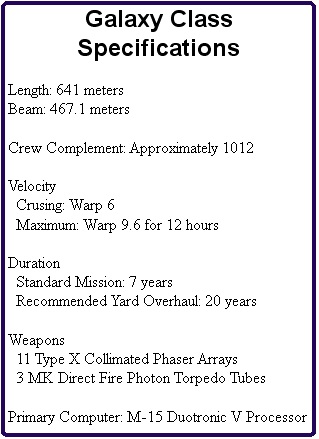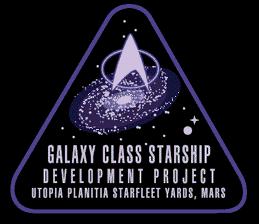

![]()
 Galaxy Class ships included the flagship of
Starfleet, U.S.S. Enterprise-D. The primary role of Galaxy Class ships are to
explore deep space and carry out diplomatic relations for the United Federation
of Planets.
Galaxy Class ships included the flagship of
Starfleet, U.S.S. Enterprise-D. The primary role of Galaxy Class ships are to
explore deep space and carry out diplomatic relations for the United Federation
of Planets.
Secondary roles for the Galaxy class ships include scientific, biological,
cultural, and ecological research processes. The ships feature a wide-range of
sensors. The ships can hold up to 225 personnel for specialized teams.
Main Bridge
The Main Bridge is located on Deck 1. Numerous stations
were featured on the bridge.
The Main Bridge featured seating for the captain, first
officer, and one additional officer. The captainís chair featured two small
consoles. These featured simplified conn and ops controls. They also feature
computer access and access to the shipís intercom system.
The conn and ops controls are featured right in the
front of the bridge. Directly in front of these two stations is the main viewer.
The command center is directly behind conn and ops. Tactical is behind and on an
elevated platform. Five stations behind tactical is for additional personnel
including engineering and mission ops.
Adjoined to the Main Bridge, is the captainís ready
room and the observation lounge. The observation lounge is a place where
meetings would take place with the senior staff or dignitaries.
From the Main Bridge, two turbolifts are featured. One
turbolift provided direct access to the battle bridge.
Stations
Flight Control or Conn- Navigation control of
the ship
Operations Management- Schedules resources and
hardware for the ship
Tactical- Defensive systems control and internal
security for the ship
Science Stations 1 & 2- Provides staff with
scientific data
Mission Ops- Provides additional support to the
Operations Manager
Environment- Permits monitoring and control of
the life support system aboard the ship
Engineering- Duplicates the Chief Engineerís
functions in Main Engineering
Battle Bridge
The Battle Bridge was developed as a backup for the
Main Bridge or the primary control system if the ship was in separation mode. It
is located on Deck 8.
The Battle Bridge doesnít have all the stations that
are featured on the Main Bridge to save space. The Battle Bridge was
replaceable.
Saucer Separation
In emergency situations, the Galaxy class ship will
separate into two different independent spacecrafts. In a battle, civilian
personnel will be evacuated to the saucer section while the stardrive will go
into battle.
Main Engineering
Main Engineering on Galaxy Class ships is located on
Deck 36. It an emergency situation, Main Engineering can be used as a backup
control center.
The warp core runs through Main Engineering and other
decks. The area in front of the warp core is the chief engineerís office. The
office featured the same controls as the rest of Main Engineering. The Galaxy
class ship travels at 9.2 sustainable. The ship can reach 9.6 for up to 12
hours.
In an emergency, Main Engineering would be evacuated.
Two isolation doors would seal off the core and forcefields would go up. In the
worst-case scenario, the entire warp core would be jettisoned into space.
Engineering Systems
Impulse Engines
Impulse engines provide space in normal conditions. It
also provides a secondary power supply for the shipís systems. Main impulse
power can provide enough power for the entire ship.
The four main impulse engines are located on Deck 23.
Navigational Deflector
The navigation deflector provides the ship with a clear
path to travel at warp speeds. It pushes anything aside that could cause damage
to the ship.
The deflector beam itself is a graviton beam that is
focused and manipulated by a series of subspace field coils. The emission sweeps
thousands of kilometers ahead of the ship. If it is unable to push aside a
larger object, it will make automatic course corrections.
Sensors
The ships feature a wide variety of sensors. The ship
can provide long-range sensor scans while at warp speed. While in orbit,
short-range sensors will provide data about the planet, other ships, or special
anomalies. Long-range sensors can provide data for up to 17 light-years,
however, the data was low-resolution.
Skeletal System
The Galaxy class skeletal structure takes approximately
five years to complete. It is mostly constructed from tritanium and duranium.
The entire framework was connected in a way that
replacing small section of the framework was possible.
Sickbay
Galaxy class ships feature an extensive sickbay. It is
located on Deck 12. There is a primary and secondary sickbay.
The primary sickbay is located on the port side and
features numerous biobeds, a laboratory, chief medical officerís office, and a
nursery.
The secondary sickbay is located on the starboard side,
It features two surgery rooms, a physical therapy ward, and an additional
nursery.
Sickbay features a wide-range of services. It is
capable of providing treatment to numerous different alien species.
Ten-Forward
Members of the crew will relax and grab food or a drink
in the Ten-Forward lounge. The windows in the lounge provide a forward view of
space. It is the most forward part of the ship.
Auto-Destruct Systems
In an extreme emergency, a Galaxy Class ship can be
vaporized. The ships feature two independent auto-destruct systems. The ship can
still auto-destruct even if is in separation mode.
Autonomous subprocessor nodes located throughout the
ship ensure that the ship can still be destroyed even if the main computer is
offline.
The primary auto-destruct system causes a massive
matter/antimatter explosion. The warp core safety interlocks are compromised and
then all the antimatter in the storage pods on Deck 42 and the matter in the
primary deuterium tanks are released simultaneously.
The secondary system features ordnance packages located
throughout the ship. It will also overload the fusion reaction chambers. In
separated operating mode, this method is the primary way to destruct the saucer
section.
Shuttlebay
Galaxy Class ships have three major facilities for
auxiliary spacecraft.
The Main Shuttlebay is located on Deck 4. Two
additional shuttlebays are located on Deck 13. Shuttlebay 2 had a dedicated
maintenance bay for servicing sensor arrays.
Shuttlebay 3 is capable of providing short-term
atmosphere for Class H, K. or L environments.
Captainís Yacht
Galaxy Class Ships carry a captainís yacht. It is
located under the saucer section. It measures 18 meters long, 10 meters wide,
and 8 meters high.
The yachtís primary mission is to transport personnel
or dignitaries when transports were inoperable or inappropriate.
It features a flight deck, two staterooms,
accommodation for the flight crew, and a galley.
It can travel up to Warp 7.0. It is capable of landing
on several land surfaces.

Views
![]()